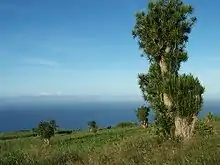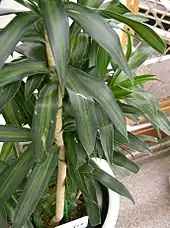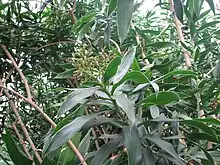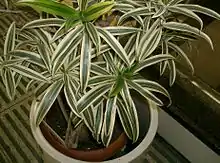| Dracaena reflexa | |
|---|---|
 | |
| Mature specimens of Dracaena marginata on Réunion Island. | |
| Scientific classification | |
| Kingdom: | Plantae |
| Clade: | Tracheophytes |
| Clade: | Angiosperms |
| Clade: | Monocots |
| Order: | Asparagales |
| Family: | Asparagaceae |
| Subfamily: | Nolinoideae |
| Genus: | Dracaena |
| Species: | D. reflexa |
| Binomial name | |
| Dracaena reflexa | |
| Synonyms[2] | |
| |
Dracaena reflexa (commonly called song of India[3] or song of Jamaica) is a tree native to Mozambique, Madagascar, Mauritius, and other nearby islands of the Indian Ocean.[2] It is widely grown as an ornamental plant and houseplant, valued for its richly coloured, evergreen leaves, and thick, irregular stems.
Description
While it may reach a height of 4–5 m, rarely 6 m in ideal, protected locations, D. reflexa is usually much smaller, especially when grown as a houseplant. It is slow-growing and upright in habit, tending to an oval shape with an open crown. The lanceolate leaves are simple, spirally arranged, 5–20 cm long and 1.5–5 cm broad at the base, with a parallel venation and entire margin; they grow in tight whorls and are a uniform dark green.[4][5]
The flowers are small, clustered, usually white and extremely fragrant, appearing in mid winter. Neither the flowers nor the fruit are especially showy. D. reflexa var. angustifolia (syn. D. marginata) differs in having a magenta tint to its flowers, a shrubby habit, and olive green leaves.[6]
Taxonomy
Dracaena reflexa was first described by Jean-Baptiste Lamarck in 1786. It has been placed in several other related genera, including Cordyline and Pleomele.[2]
Varieties
.jpg.webp)
As of November 2017, the World Checklist of Selected Plant Families accepts the following varieties, most described from Madagascar:[7]
- Dracaena reflexa var. angustifolia Baker – western Indian Ocean islands
- Dracaena reflexa var. bakeri (Scott Elliot) H.Perrier – south-east Madagascar
- Dracaena reflexa var. brevituba H.Perrier – central Madagascar
- Dracaena reflexa var. condensata H.Perrier – south-east Madagascar
- Dracaena reflexa var. lanceolata H.Perrier – Madagascar
- Dracaena reflexa var. linearifolia Ayres ex Baker – Mascarenes, Madagascar
- Dracaena reflexa var. nervosa H.Perrier – Madagascar
- Dracaena reflexa var. occidentalis H.Perrier – west and south-west Madagascar
- Dracaena reflexa var. parvifolia Thouars ex H.Perrier – east Madagascar
- Dracaena reflexa var. reflexa – north-east Mozambique, western Indian Ocean islands
- Dracaena reflexa var. salicifolia (Regel) Baker – Madagascar
- Dracaena reflexa var. subcapitata H.Perrier – east Madagascar
- Dracaena reflexa var. subelliptica H.Perrier – east Madagascar
Cultivation and uses


Dracaena reflexa is a popular ornamental plant, both in the landscape and the home. It can be enjoyed as a specimen plant, accent, or pruned to create a border. Several cultivars have been selected, particularly variegated clones with cream and yellow-green margins. It performs well as a houseplant, tolerating infrequent waterings. It prefers bright, filtered light, without direct sun exposure, restricted outdoors to zones 10–11. It has average water needs and should be fertilized bi-weekly when actively growing. Although it can survive in relatively low light levels, the plant may grow spindly if given insufficient light. When grown indoors, temperatures of 18 °C to 25 °C (64 °F to 77 °F) should be maintained. It can be propagated via herbaceous stem cuttings.
The cultivar Dracaena reflexa ‘Variegata’ has gained the Royal Horticultural Society’s Award of Garden Merit.[8] (confirmed 2017)[9]
Traditional medicine practitioners of Madagascar have long believed Dracaena reflexa to cure malarial symptoms, poisoning, dysentery, diarrhea, dysmenorrhea, and to be useful as an antipyretic and hemostatic agent. The leaves and bark are mixed with parts of a number of other native plants and mixed into herbal teas. Its effectiveness in any such treatment remains unproven.[10]

The fruit of D. reflexa is also important to the diet of the Malagasy black-and-white ruffed lemur (Varecia variegata variegata).[11] The Frégate beetle (Polposipus herculeanus), an endangered species endemic to Frégate Island (Seychelles), is also known to associate with this plant.[12]
Dracaena reflexa var. angustifolia

Dracaena reflexa var. angustifolia is also known as D. marginata,[13] a name found in horticulture. This is a durable popular tropical house plant from Madagascar. The thin leaves are linear and a deep, glossy green color with red edges; typically 30–90 cm long and 2–7 cm broad, tapering to an acuminate point. It is a popular houseplant that needs little attention, with several cultivars available with the leaves variegated with red or pale yellow.
It requires a minimum temperature of 15 °C (59 °F), and is more tolerant than most plants of dry soil and irregular watering, though liable to root decay in permanently wet soil. Because it requires minimal care it is very popular in offices where the constant heat and light suits its growing requirements. They can grow between 2.5–4 meters in height and will ultimately spread between 1.5 and 2.5 meters.[14]
There are many commonly used names to describe this variety that arise due to the various growth patterns and different cultivars. Some of the most popular are red edge dracaena, Madagascar dragon tree dracaena, dragon blood tree, and tree dracaena.[15] With the variety of forms and cultivars, there are also some hybrid crosses that can arise as well.
The cultivar 'Tricolor' has gained the Royal Horticultural Society's Award of Garden Merit.[16]
Versatility
The plant can be grown in virtually any pattern, with the most popular being bush, straight cane, staggered cane, tree form, and custom character forms. The variety also has a handful of different cultivars from selective breeding. These include 'Tarzan', 'Magenta', 'Tricolor', and 'Colorama'.[15]
Uses
It is one of the plants used in the NASA Clean Air Study and has shown to help remove formaldehyde.[17] It is an effective air cleaner and is said to be among the best plants for removing xylene and trichloroethylene.[18]
References
- ↑ Botanic Gardens Conservation International (BGCI) & IUCN SSC Global Tree Specialist Group (2019). "Dracaena reflexa". IUCN Red List of Threatened Species. 2019: e.T68150169A149011017. Retrieved 2021-12-17.
- 1 2 3 4 "Dracaena reflexa". World Checklist of Selected Plant Families. Royal Botanic Gardens, Kew. Retrieved 2017-11-14.
- ↑ "Dracaena reflexa". Germplasm Resources Information Network. Agricultural Research Service, United States Department of Agriculture. Retrieved 2017-12-07.
- ↑ Huxley, A., ed. (1992). New RHS Dictionary of Gardening. Macmillan.
- ↑ Gilman, E. F. (1999). Fact Sheet FPS-187: Dracaena reflexa. Environmental Horticulture Department, Florida Cooperative Extension Service, Institute of Food and Agricultural Sciences, University of Florida. Retrieved April 18, 2006 from "Archived copy" (PDF). Archived (PDF) from the original on 2006-11-01. Retrieved 2006-04-18.
{{cite web}}: CS1 maint: archived copy as title (link) - ↑ Missouri Botanical Garden. Dracaena reflexa var. angustifolia Baker. Conspectus of the Vascular Plants of Madagascar. Retrieved April 18, 2006 from "Dracaena reflexa var. Angustifolia Baker". Archived from the original on 2016-03-03. Retrieved 2006-04-18.
- ↑ "Search for Dracaena reflexa". World Checklist of Selected Plant Families. Royal Botanic Gardens, Kew. Retrieved 2017-11-14.
- ↑ "RHS Plantfinder - Dracaena reflexa 'Variegata'". Retrieved 12 February 2018.
- ↑ "AGM Plants - Ornamental" (PDF). Royal Horticultural Society. July 2017. p. 33. Retrieved 24 January 2018.
- ↑ Randrianarivelojosia, R.; et al. (2003). "Plants traditionally prescribed to treat tazo (malaria) in the eastern region of Madagascar". Malaria Journal. 2: 25. doi:10.1186/1475-2875-2-25. PMC 184444. PMID 12921540.
- ↑ Britt, A (2000). "Diet and Feeding Behaviour of the Black-and-White Ruffed Lemur (Varecia variegata variegata) in the Betampona Reserve, Eastern Madagascar". Folia Primatologica. 71 (3): 133–141. doi:10.1159/000021741. PMID 10828690. S2CID 11002097.
- ↑ Ferguson, A., Pearce-Kelly, P. (2004). The Frégate Island giant tenebrionid beetle. Management Guidelines For the Welfare of Zoo Animals. The Federation of Zoological Gardens of Great Britain and Ireland. London, UK. ISSN 0963-1712. Retrieved April 18, 2006 from http://www.zoofederation.org.uk/uploads/Management%2520Guidelines%2520-%2520Fregate%2520beetle%252007-11-04.pdf%5B%5D
- ↑ "Dracaena marginata". World Checklist of Selected Plant Families. Royal Botanic Gardens, Kew. Retrieved 2017-11-14.
- ↑ "RHS (Royal Horticultural Society)". November 2017.
- 1 2 "Dracaena Marginata Care: Growing The Red Edged Madagascar Dragon Tree". Plant Care Today. 2017-09-01. Retrieved 2017-09-22.
- ↑ "Dracaena marginata 'Tricolor'". RHS. Retrieved 5 May 2020.
- ↑ B.C. Wolverton; Rebecca C. McDonald; E. A. Watkins Jr. (September 15, 1989). "Foliage Plants for Removing Indoor Air Pollutants from Energy-efficient Homes" (PDF). Retrieved 2022-01-19.
- ↑ Wolverton, B.C. (1996). How to Grow Fresh Air. New York: Penguin Books. p. 72. ISBN 0-14-026243-1.
Bibliography
- Huxley, A. (1992). New RHS Dictionary of Gardening 2: 96–97. Macmillan.
External links
 Media related to Dracaena marginata at Wikimedia Commons
Media related to Dracaena marginata at Wikimedia Commons Media related to Dracaena reflexa at Wikimedia Commons
Media related to Dracaena reflexa at Wikimedia Commons
